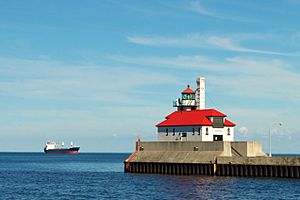Duluth South Breakwater Outer Light facts for kids
 |
|
| The Duluth South Breakwater Outer Light from the northwest | |
|
|
|
| Location | Lake end of south breakwater of the Duluth Ship Canal, Duluth, Minnesota |
|---|---|
| Coordinates | 46°46′48.3″N 92°5′16″W / 46.780083°N 92.08778°W |
| Year first constructed | 1874 |
| Year first lit | 1901 |
| Automated | 1976 |
| Foundation | Concrete pier |
| Construction | Brick |
| Tower shape | House with square tower |
| Markings / pattern | White with red roof |
| Focal height | 44 ft (13 m) |
| Original lens | Fourth order Fresnel lens |
| Range | 13 nautical miles (24 km; 15 mi) |
| Characteristic | Fixed Green |
| Fog signal | Horn |
| USCG number | 7-15845 |
The Duluth South Breakwater Outer Light is a cool lighthouse in Duluth, Minnesota. It stands on the south breakwater of the Duluth Ship Canal. This lighthouse works with another one, the Duluth South Breakwater Inner Light, to help ships find their way safely into the canal from Lake Superior. Think of them as a team guiding boats home!
Contents
History of the Duluth Lighthouse
Building the First Lighthouse
Money was set aside in 1870 to build this lighthouse. The plan was to put it at the end of the Northern Pacific Railroad docks. But bad storms caused delays. So, construction didn't start until 1872. By then, the ship canal had already been dug.
A tall, wooden tower was built first. It had a special light called a fifth-order Fresnel lens. This lens helped make the light very bright. A raised walkway led from the tower back down the pier. The main lighthouse keeper had a house nearby. His helpers had to find places to stay in the city. This first tower lit up for the very first time in 1874.
Dealing with Fog and Noise
The area around Duluth is often very foggy. So, a special bell was added in 1880 to warn ships. This bell came from the South Manitou Island Lighthouse. It was the first of many fog signals used here.
In 1885, the bell was replaced by two steam-powered whistles. These whistles were put in a new building on the breakwater. The whistles were very loud! People living in the city complained about the noise. So, a special reflector was added to send the sound out towards the lake. This helped a lot.
The fog signals were used a lot. For the first ten years, they blew for about 472 hours each year. In 1895, the whistles blew for 1,048 hours. That's more than four hours a day during the eight-month shipping season!
Upgrading the Light and Signal
In 1886, the lighthouse got a better light. The old lens was replaced with a fourth-order Fresnel lens. The light's signal also changed. It went from a red and white flash to a steady red light.
In the late 1890s, the ship canal was rebuilt. This meant the old wooden tower and fog signal building were replaced. A new, single brick lighthouse was built. It held both the light and the fog signals. This new building was finished in 1901. The new light turned on for the first time on September 1 of that year.
The new lighthouse was made of "Cream City brick." The light tower was on one corner of the building. It still used the same lens from the old light. The loud fog whistles were also moved to the new building.
More Whistles and Complaints
In 1915, the old whistles were replaced with even louder ones, like those on a train! Then, in 1921, they were changed again to Type F diaphones. These were also very noisy. This caused more complaints from city residents. So, another sound reflector was installed to direct the noise.
In 1968, the diaphones were replaced with an electronic horn. But in 1976, a group called TOOT (which stood for "reTurn Our Old Tone") started a campaign. They wanted the old fog signal back! Horns from the Kewaunee Pierhead Light were found. In 1995, the diaphones were put back into service. Of course, this brought new noise complaints! Because of the complaints, the signal was only allowed to blow during the daytime.
The fog signal needed a special type of electricity to work. When this power failed in 2005, the Coast Guard decided not to pay for repairs. The city also refused to pay. So, the fog signal was taken apart the next year. Even without the fog signal, the lighthouse still works today. It shines a steady green light for ships.
Historic Landmark Status
The Duluth South Breakwater Outer Light was added to the National Register of Historic Places in 2016. This means it's an important historical site. It was recognized for its role in engineering, maritime history, and transportation. It shows how the government worked to create navigation aids across the country. It's also a great example of early 20th-century harbor lighthouses built around the Great Lakes.


